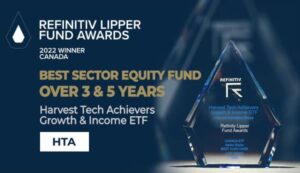Markets are hesitant, but large-cap tech has been resilient. Learn why large-cap technology with an income strategy can help investors now.
By James Learmonth, Senior Portfolio Manager, Harvest ETFs
(Sponsor Content)
After recovering from some of their 2022 shocks early this year, markets have been trepidatious through most of 2023. That recovery and volatility story, on paper, looks broad based. Between January and mid-May, the S&P 500 is up around 8-9%. The S&P 500 Information Technology index, however, is up over 25% in the same rough time period. That outperformance skews even higher when we isolate some of the largest names in the technology sector.
So while overall market performance this year has been steady, turning choppier since the US banking crisis began in March, large-cap tech leaders are doing what they tend to do: lead.
In a macro environment of market uncertainty, high inflation and tech outperformance, one strategy can give investors exposure to large-cap technology companies, while providing income and ballast against volatility.
Why Large-cap Tech has been a leader
To understand how a tech income strategy can help investors, it’s worthwhile to unpack what has made technology a leading sector so far in 2023.
Q1 earnings season for tech shed some light on the sector’s outperformance. Part of that performance is due to a more broadly positive market sentiment in 2023, compared to 2022, in addition to some recovery following the sector’s struggles last year. Notable, however, is the positive reception large-cap companies have received for their artificial intelligence (AI) strategies.
AI has been the hot new topic this year, and large-cap tech companies have been quick to capitalize on the rapid pace of innovation in this space. Whether they are innovating their own AI tech, or applying AI to new areas these companies are creating serious value for shareholders with this technology.
It’s worth emphasizing the dominance of large-caps in this moment, companies like Meta, Apple, and Microsoft. In recent history, major tech leaps have been associated with ‘disruption’ of traditional larger players. So far in the rise of AI we’ve seen the largest companies leading, demonstrating their value as innovators and appliers of innovation.
Why Volatility is persisting in the broader market
Despite all the positivity in large-cap technology, broad markets have been choppy this year. Most of their recovery took place in the first months of 2023, and since the onset of a US banking crisis in March market performance has been choppy up and down, aggregating out flat.
Macro forces are largely to blame. The banking crisis highlighted the ongoing impacts of rapid rate hikes by central bankers starting last year. Even as that hiking period seems to be ending, the consequences of those raised rates will be felt over the next several months. More recently, fears about the US debt ceiling have troubled markets while geopolitics continues to impact sentiment.
In short, tech is leading a market that hasn’t yet found true stability. The question then, is where can investors turn?
A Tech ETF for income and volatility
 The Harvest Tech Achievers Growth & Income ETF (HTA:TSX) is designed to deliver exposure to tech’s largest leaders. With a portfolio of 20 companies, screened by market cap and selected for diversification, HTA brings broad-based diversity, including companies like NVIDIA specializing in semiconductors, Accenture in IT services, and Cisco in communications as well as the traditional software, social media, and device leaders.
The Harvest Tech Achievers Growth & Income ETF (HTA:TSX) is designed to deliver exposure to tech’s largest leaders. With a portfolio of 20 companies, screened by market cap and selected for diversification, HTA brings broad-based diversity, including companies like NVIDIA specializing in semiconductors, Accenture in IT services, and Cisco in communications as well as the traditional software, social media, and device leaders.
In addition to that diversified portfolio, HTA uses an active & flexible covered call option strategy to generate a high monthly income distribution. The ETF sells covered calls, effectively the right to buy shares on a future date at today’s price, to generate premiums. Those premiums are bundled with any dividends and passed on to unitholders as income.
While the call option strategy inherently foregoes some upside for that income, the active nature of HTA’s strategy can optimize that exchange and give investors positive exposure to market volatility.
Like all Harvest Equity Income ETFs, HTA has a maximum 33% write limit applied to its entire portfolio. That means at least 67% of the portfolio is exposed to market upside potential at all times. Within that 33% limit, too, HTA’s portfolio managers are empowered to actively write covered calls on as much or as little of the portfolio as necessary to generate the ETF’s income distribution. When markets get volatile, call options can generate higher premiums. So HTA can effectively monetize market volatility, while retaining exposure to large-cap tech leaders.
Large-cap tech has shown attractive qualities in a rocky market environment, but the overall macro picture still points to instability. We believe that a strategy like HTA, combining large-cap tech leaders with a volatility-oriented active covered call strategy, can be of real benefit to Canadian investors in this environment.
 James Learmonth is a Senior Portfolio Manager for Harvest ETFs. He is responsible for Harvest’s Information Technology, US Financials, and Global Brand Leaders ETFs and is a 20+ year veteran of the financial services industry.
James Learmonth is a Senior Portfolio Manager for Harvest ETFs. He is responsible for Harvest’s Information Technology, US Financials, and Global Brand Leaders ETFs and is a 20+ year veteran of the financial services industry.



